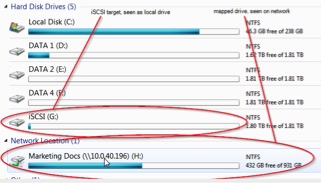What are the differences between NAS shares and ISCSI shares?
This article describes the differences between NAS shares and ISCSI shares.
Environment
- Datto ALTO
- Datto SIRIS
- Datto NAS
Description
Shares hosted on the Datto device are capped at 16TB in size. NAS shares are dynamically expanding on the device and are not assigned a size on creation.
A NAS share displays as a network location and is made accessible via a mapped drive, while an ISCSI share displays as a local drive letter on the machine. Other major differences are outlined below.
NAS Shares
Network Attached Storage, commonly known as a NAS share, is file-level storage that displays as a drive on the network. The drive can be mapped from any machine on the network and assign it a drive letter.
A NAS share is shared storage, so multiple computers on the network can access it at the same time. The term NAS is also synonymous with the hardware appliance where the share lives.
File permissions or individual ACL attributes cannot be set at the file or folder level. Access control is determined by the permissions set in the share’s root directory.
NOTE If granular file permissions or the use of Active Directory ACLs is required use an iSCSI share that is hosted by a domain-controlled server.
iSCSI Shares
Internet Small Computer System Interface, known as iSCSI, lets a computer connect via the SCSI protocol(external link) with storage targets that exist on a network instead of being directly attached to the computer.
An iSCSI share is block-level storage. This type of storage behaves like a physical drive directly attached to a computer. In this case, the share is referred to as an iSCSI target, which you can connect to via an ISCSI initiator.
Windows includes an iSCSI initiator that allows iSCSI shares on a Datto device to display as local drives on any computer on the network.
iSCSI targets can only be accessed by one user at a time unless you have specialized software.
File permissions and ACL attributes can be set at the file or folder level and are preserved in the event of a restore.
iSCSI shares are not able to be re-sized. They are configured on creation and may not be expanded.



